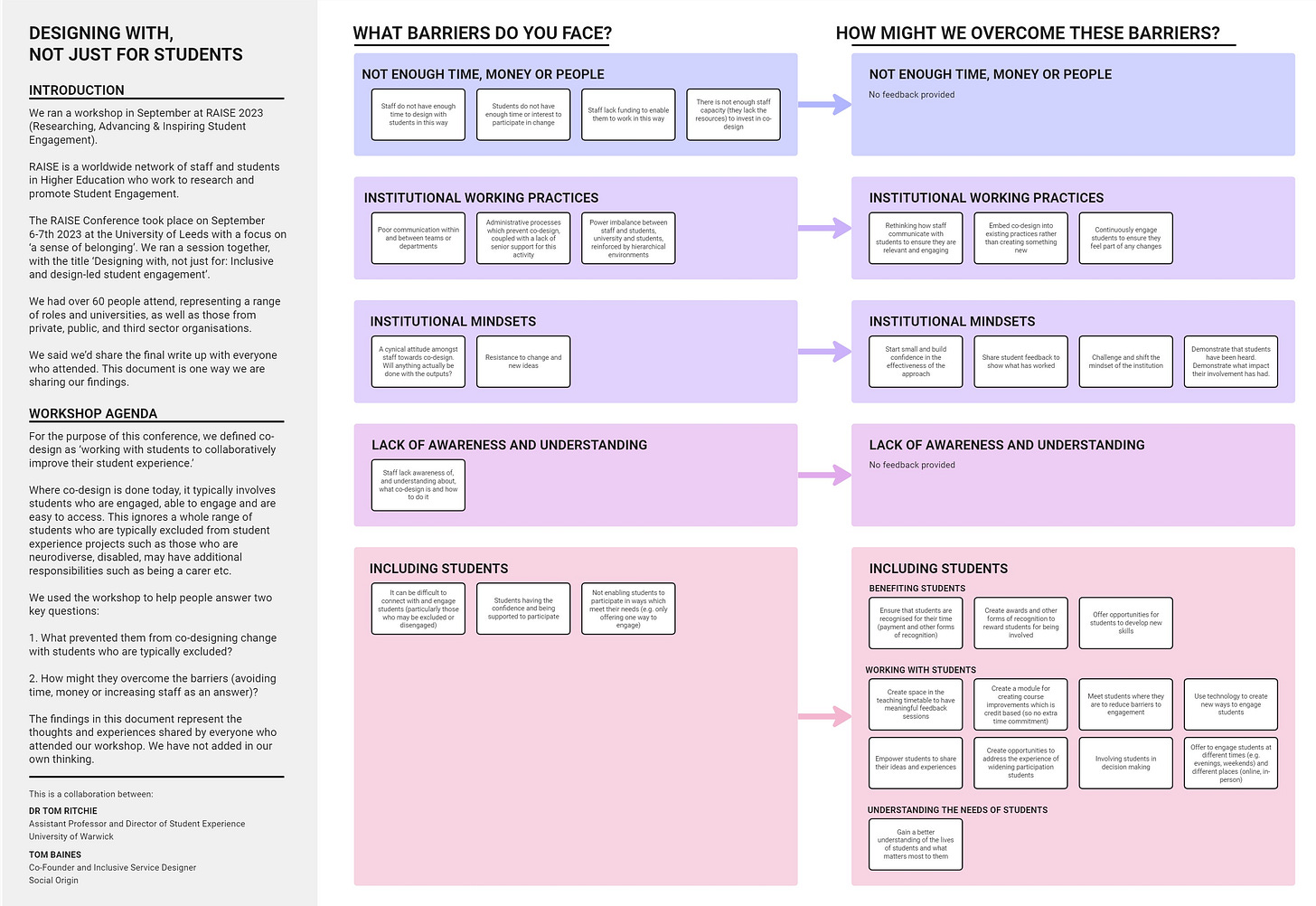RAISE Conference Workshop Write Up
Sharing a write up of our RAISE Conference Workshop on designing with, not for students.
Introduction
We ran a workshop in September at RAISE 2023 (Researching, Advancing & Inspiring Student Engagement). RAISE is a worldwide network of staff and students in Higher Education who work to research and promote Student Engagement.
The RAISE Conference took place on September 6-7th 2023 at the University of Leeds with a focus on ‘a sense of belonging’. We ran a session together, with the title ‘Designing with, not just for: Inclusive and design-led student engagement.’ We had over 60 people attend, representing a range of roles and universities, as well as those from private, public, and third-sector organisations.
We said we’d share the final write-up with everyone who attended. This post is one way we are sharing our findings.
Workshop agenda
For the purpose of this conference, we defined co-design as ‘working with students to collaboratively improve their student experience.’
Where co-design is done today, it typically involves students who are engaged, able to engage and are easy to access. This ignores a whole range of students who are typically excluded from student experience projects such as those who are neurodiverse, disabled, and may have additional responsibilities such as being a carer.
We used the workshop to help people answer two key questions:
What prevented them from co-designing change with students who are typically excluded?
How might they overcome the barriers (avoiding time, money or increasing staff as an answer)?
About this write up
We have reviewed and consolidated the workshop outputs into a set of five main barriers. This post contains:
Barrier theme title
Examples of each barrier
Potential solutions to overcome each barrier.
The findings in this post represent the thoughts and experiences shared by everyone who attended our workshop. We have not added in our own thinking.
As well as this post, you can also view our findings in the image below. Both formats contain exactly the same information.
Workshop findings
Barrier 1: Not enough time, money or people
Examples of this barrier:
Staff do not have enough time to design with students in this way.
Students do not have enough time or interest to participate in change.
Staff lack funding to enable them to work in this way.
There is not enough staff capacity (they lack the resources) to invest in co-design.
Potential ways to overcome this barrier:
No feedback was provided against this theme.
Barrier 2: Institutional working practices
Examples of this barrier:
Poor communication within and between teams or departments
Administrative processes which prevent co-design, coupled with a lack of senior support for this activity.
Power imbalance between staff and students, university and students, reinforced by hierarchical environments.
Potential ways to overcome this barrier:
Rethinking how staff communicate with students to ensure they are relevant and engaging.
Embed co-design into existing practices rather than creating something new.
Continuously engage students to ensure they feel part of any changes.
Barrier 3: Institutional mindsets
Examples of this barrier:
A cynical attitude amongst staff towards co-design. Will anything actually be done with the outputs?
Resistance to change and new ideas.
Potential ways to overcome this barrier:
Start small and build confidence in the effectiveness of the approach.
Share student feedback to show what has worked.
Challenge and shift the mindset of the institution.
Demonstrate that students have been heard. Demonstrate what impact their involvement has had.
Barrier 4: Awareness and understanding
Examples of this barrier:
Staff lack awareness of, and understanding about, what co-design is and how to do it.
Potential ways to overcome this barrier:
No feedback was provided against this theme.
Barrier 5: Including students
Examples of this barrier:
It can be difficult to connect with and engage students (particularly those who may be excluded or disengaged)
Students having the confidence and being supported to participate.
Not enabling students to participate in ways which meet their needs (e.g., only offering one way to engage)
Potential ways to overcome this barrier: multiple ideas were shared against this theme. We have grouped them into three categories, so they are easier to read.
Benefiting students
Ensure that students are recognised for their time (payment and other forms of recognition)
Create awards and other forms of recognition to reward students for being involved.
Offer opportunities for students to develop new skills.
Working with students
Create space in the teaching timetable to have meaningful feedback sessions.
Create a module for creating course improvements which is credit-based (so no extra time commitment)
Meet students where they are to reduce barriers to engagement.
Use technology to create new ways to engage students.
Empower students to share their ideas and experiences.
Create opportunities to address the experience of widening participation students.
Involving students in decision-making
Offer to engage students at different times (e.g., evenings, weekends) and different places (online, in-person)
Understanding the needs of students
Gain a better understanding of the lives of students and what matters most to them.
What next?
As always, we’d love to hear what you think. Please let us know what we have missed, what you’d like to hear more of and what we can explore in future posts.
You can also listen to our podcast, where we reflect on the conference and talk about these results, as well as wider implications.
Link to podcast: https://designwithstudents.substack.com/p/52eb8496-b0f0-4586-9da8-f7324f92b62c
Please share your thoughts in the comments to help us keep this important conversation going.



